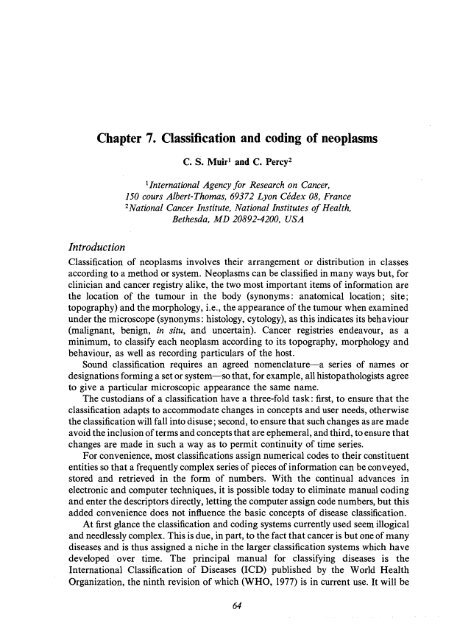Cancer Registration: Principles and Methods - IARC
Cancer Registration: Principles and Methods - IARC
Cancer Registration: Principles and Methods - IARC
Create successful ePaper yourself
Turn your PDF publications into a flip-book with our unique Google optimized e-Paper software.
Chapter 7. Classification <strong>and</strong> coding of neoplasms<br />
C. S. Muirl <strong>and</strong> C. Percy2<br />
International Agency for Research on <strong>Cancer</strong>,<br />
150 cours Albert-Thomas, 69372 Lyon Cidex 08, France<br />
2National <strong>Cancer</strong> Institute, National Institutes of Health,<br />
Bethesda, MD 20892-4200, USA<br />
Introduction<br />
Classification of neoplasms involves their arrangement or distribution in classes<br />
according to a method or system. Neoplasms can be classified in many ways but, for<br />
clinician <strong>and</strong> cancer registry alike, the two most important items of information are<br />
the location of the tumour in the body (synonyms: anatomical location; site;<br />
topography) <strong>and</strong> the morphology, i.e., the appearance of the tumour when examined<br />
under the microscope (synonyms: histology, cytology), as this indicates its behaviour<br />
(malignant, benign, in situ, <strong>and</strong> uncertain). <strong>Cancer</strong> registries endeavour, as a<br />
minimum, to classify each neoplasm according to its topography, morphology <strong>and</strong><br />
behaviour, as well as recording particulars of the host.<br />
Sound classification requires an agreed nomenclature-a series of names or<br />
designations forming a set or system-so that, for example, all histopathologists agree<br />
to give a particular microscopic appearance the same name.<br />
The custodians of a classification have a three-fold task: first, to ensure that the<br />
classification adapts to accommodate changes in concepts <strong>and</strong> user needs, otherwise<br />
the classification will fall into disuse; second, to ensure that such changes as are made<br />
avoid the inclusion of terms <strong>and</strong> concepts that are ephemeral, <strong>and</strong> third, to ensure that<br />
changes are made in such a way as to permit continuity of time series.<br />
For convenience, most classifications assign numerical codes to their constituent<br />
entities so that a frequently complex series of pieces of information can be conveyed,<br />
stored <strong>and</strong> retrieved in the form of numbers. With the continual advances in<br />
electronic <strong>and</strong> computer techniques, it is possible today to eliminate manual coding<br />
<strong>and</strong> enter the descriptors directly, letting the computer assign code numbers, but this<br />
added convenience does not influence the basic concepts of disease classification.<br />
At first glance the classification <strong>and</strong> coding systems currently used seem illogical<br />
<strong>and</strong> needlessly complex. This is due, in part, to the fact that cancer is but one of many<br />
diseases <strong>and</strong> is thus assigned a niche in the larger classification systems which have<br />
developed over time. The principal manual for classifying diseases is the<br />
International Classification of Diseases (ICD) published by the World Health<br />
Organization, the ninth revision of which (WHO, 1977) is in current use. It will be
















